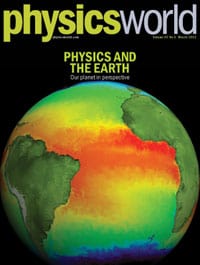By Matin Durrani

If you’re a member of the Institute of Physics (IOP), you’ll have had access for more than a week now – through our apps, in print or online – to the bumper 92-page March issue of Physics World magazine, which features a series of fabulous articles and images on the theme of “Physics and the Earth”.
If you’re not yet a member of the IOP, then to get a taste of what you’re missing out on each month, we’re offering a free PDF download of the March issue via this link.
Here’s a brief outline of what’s in the March issue and I’ve included details at the end of this blog about how to join the IOP so that you can get your hands on Physics World each and every month. Joining is easy and costs just £15, €20 or $25 a year.
• Gianpaolo Bellini and Livia Ludhova describe how geoneutrinos generated through radioactive decay within the Earth are providing a new technique for understanding our planet.
• François Pétrélis, Jean-Pierre Valet and Jean Besse explain why they think that the movement of the Earth’s plates could be linked to the rate of reversal of the Earth’s magnetic field.
• See what progress is being made in understanding the Earth’s core – including the bizarre possibility that it may hide huge crystals of iron some 10 km long.
• Learn more about the controversy over fracking, which involves pumping sand and chemicals into shale deposits to release trapped natural gas.
• Check out our interview with Robert Hazen, the head of the Deep Carbon Observatory, who wants to find out what happens to carbon that gets subducted into the Earth’s core.
• Mike Weightman, chief inspector of nuclear installations and executive head of the Office for Nuclear Regulations in the UK, describes what lessons we can learn from the incident at the Fukushima Daiichi plant one year on.
• Enjoy a series of spectacular images of the Earth from afar, showing the power of Earth observation.
• Find out how the latest advances in earthquake forecasting can give the odds that an earthquake above a certain size will occur within a given area and time.
Download a PDF of the issue now.
Remember, to get Physics World each month, you can join the IOP as an imember for just £15, €20 or $25 a year via this link. Being an imember gives you a full year’s access to Physics World, both online and through the apps.
Members of the IOP can also read the March issue through the digital version of the magazine by following this link or by downloading the Physics World app onto your iPhone or iPad or Android device, available from the App Store and Android Marketplace, respectively. The digital version lets you read, share, save, archive and print articles – either fully laid out or in text view – and even have them translated or read out to you.
To let us know what you think about the March issue, please e-mail us at pwld@iop.org.
Enjoy the issue!



